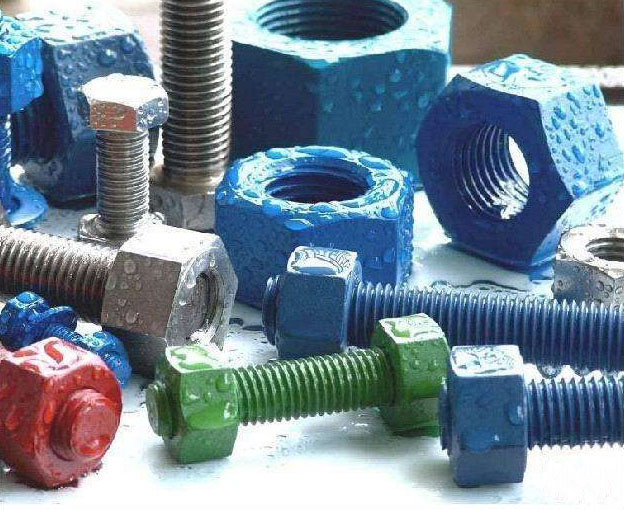Dacromet surface treatment technology and development
In the 1950s, Dacromet was born in Dayang Corporation in the United States. In the 1970s, the Japanese NDS company bought out the Dacromet technology use rights in the Asia-Pacific region from the US MCII company. In the domestic traditional Dacromet technology is commonly known as: water-based zinc-chromium film coating, zinc-based coating, flake zinc-based chromium salt protective coating, non-electrolytic zinc chromate coating, dacola, etc. The traditional Dacromet solution contains 6-8% CrO3, and it is easy to leave +6 valent chromium after processing, which can cause pollution and even carcinogenic to the human body, and cannot meet the requirements of the automobile and other industries for the content of toxic substances.

EU 2000/53/EG regulations: From July 1, 2003, every car Cr6+ <2g, the technical standard for chromium-free coating of automobile factories BMW (BMW) ---GS90010 Ford (FORD) ---WSS-M21P42, WSS- M21P39 Volkswagen (VW)---TL245, TL233 (2002 version) General (GM)---GMW3359, GM7111M Volvo (VOLVO)---VCS5737.29 In this context, the United States, Germany, Japan, China and other countries have successively R&D and improvement of Dacromet technology has formed a new type of Dacromet chromium-free coating technology.
Anti-corrosion mechanism anti-corrosion coating mainly includes:
Undercoat-Inorganic zinc-rich top layer-Organic aluminum-rich top layer-Inorganic silicate series top coating zinc self-oxidation protection: effectively control iron corrosion under the electrical action of zinc metal that is easily ionized;
Passivation: the formation of metal oxide polymers inhibits the chemical reaction of zinc and iron and delays the corrosion rate;
Isolation: The various layer structures of zinc and aluminum metal oxides alternately protect the iron surface and isolate external corrosion factors.
The new Dacromet coating technology has been extremely applied in various fields such as automobile industry, civil engineering, electric power, chemical industry, marine engineering, household appliances, railways, highways, bridges, subways, tunnels, shipbuilding, military industry and so on.
Automobile bodywork is mainly used in the pretreatment, sintering, and cooling inspection of exposed parts such as chassis fasteners and engine brackets (locations with poor environmental conditions and no appearance requirements). Surface treatment application and process flow. New Dacromet coating The whole set of process equipment of the layer adopts a closed-circuit coating method in the whole process, which eliminates the discharge and pollution sources of acid, alkali, zinc, chromium and other sewage and waste gas generated during the electroplating process.
The process flow is as follows:
In the process of forming the chromium-free film on the metal surface of the new Dacromet, almost all the volatile substances are vaporized water, which is free of pollution and pollution. Degreasing → sandblasting and curing the finished product.
Application and technological process technological process:
1 pretreatment
(1) Degreasing: Organic solvents (such as trichloroethylene, etc.) and alkaline solutions degreasing. The surface of the pre-treated parts must be completely wetted by water. Heavy oil workpieces are generally first cleaned by high-pressure cleaning with a combined cleaning machine, or with methylene chloride ultrasonic cleaning process, and then shot peened. Workpieces with less oil pollution can save the cleaning step and directly shot blasting. For example, some standard parts are shot blasted directly after coming out of the thread rolling machine, and then immersed in liquid, and then cured in the furnace.
(2) The diameter of the steel shot used by the sand blasting, dust removal and cooling shot blasting machine ranges from 0.1 to 0.6 mm. The compressed air is used to remove dust. The removed dust is collected by a special dust collector and then processed in a centralized manner. The temperature of the subsequent parts is as high as about 60 ℃, and the next process can only be carried out when it drops to 20 ℃.
2 Coating treatment
According to different coating methods, it can be divided into several methods such as dipping and drying, spraying and brushing.
(1) Dip coating and spin drying: suitable for standard parts and other small workpieces. Generally, the workpiece should be immersed in the liquid for 10-20 s, in order to fully form the passivation film; during centrifugal drying, it should be rotated forward and reverse twice, each time for 10-20 s. Fixtures are used for special parts, and manual assistance is required for difficult parts. For example, use a rod to stir in the centrifugal basket to change the position of the workpiece in the basket so that the coating liquid accumulated in the corner can be smoothly thrown away from the workpiece . The speed of the spinner should be appropriate. Too fast or too slow is not good. In short, it is necessary to ensure that there is no accumulation of liquid, hanging liquid, air bubbles, or missing coating on the parts. Process parameters such as the amount of workpiece added, the speed of the spinner, and the time of rotation are determined according to the actual coating effect through multiple forward and reverse spins and multiple adjustments of the spin speed.
(2) Spraying and brushing: generally used for large parts, for parts that are difficult to dip and spin dry. The sprayed coating is even, the coating is thick, the adhesion is poor but the finish is good, the corrosion resistance is strong but the efficiency is low.
3 curing
After the chromium-free liquid immersion treatment, the workpiece is dried and placed on the stainless steel mesh belt conveyor. For small workpieces, gloves must be worn for manual separation. The workpieces are required to not stick to each other. For larger workpieces, such as subway bolts, they must be placed on a special rack, and then the rack is placed on the mesh belt and baked in the curing oven. The curing temperature is 280 ~ 330 ℃, and the time is 25 ~ 40 min.
The curing is divided into two stages:
In the first stage, the workpiece absorbs heat and rises, which is called preheating, and the temperature is controlled at 60 to 80 ℃ for 10 min. At this stage, attention must be paid not to increase the temperature too quickly. The workpiece should be allowed to absorb heat slowly so that the moisture in the coating can gradually escape to avoid blistering and defects in the coating.
The second stage is the high-temperature curing of the coating. At this time, the temperature in the curing furnace must be controlled within the range of the process requirements, not too high or too low, because it determines the final performance of the coating on the workpiece.
4 Cooling
Due to the high curing temperature, the cured workpiece must be strongly cooled to shorten the cooling time, reduce the length of the curing furnace, and save investment costs.
5 Post-processing
Tongbao Technology is dedicated to provide our customers with high-quality products and services!! We can customize CNC automatic sandblasting equipment for you! ! ! Contact Email:sales@zjtongbao.com
Recommend
-

QQ Zone
-

Sina Weibo
-

Renren.com
-

Douban


